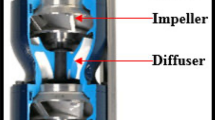Conclusions
-
1.
A considerable cavitation wear of the runner blades at the Bratsk hydroelectric power plant occurred as the result of operating the hydraulic turbines under conditions falling outside the design range and due to distortion of the blade profile caused by electrode surfacing on a large scale carried out during repairs.
-
2.
The most effective method of reducing cavitation wear was the admission of air to the cavitation zones on the runner surface.
-
3.
Air admission to the cavitation zones does not affect the power generation indices of the hydraulic turbine.
Similar content being viewed by others
Literature Cited
N. I. Pylaev and Yu. U. Édel' Cavitation in Hydraulic Turbines [in Russian] Mashinostroenie, Moscow-Leningrad (1974).
N. I. Pylaev and A. A. Sotnikov, “Air admission as a means of reducing cavitation erosion”, Énergomashinostroenie, No. 7 (1973).
Additional information
Translated from Gidrotekhnicheskoe Stroitel'stvo, No. 2, pp. 23–25, February, 1975.
Rights and permissions
About this article
Cite this article
Glukhov, I.S., Pylaev, N.I. Cavitation wear in hydraulic turbines at the Bratsk hydroelectric power plant. Hydrotechnical Construction 9, 141–145 (1975). https://doi.org/10.1007/BF02378451
Issue Date:
DOI: https://doi.org/10.1007/BF02378451




